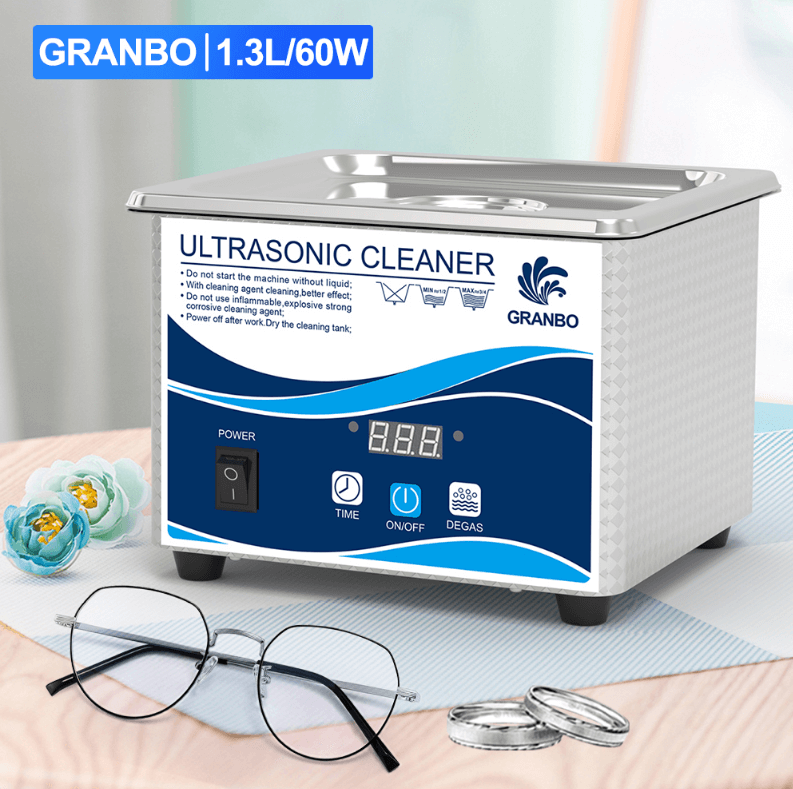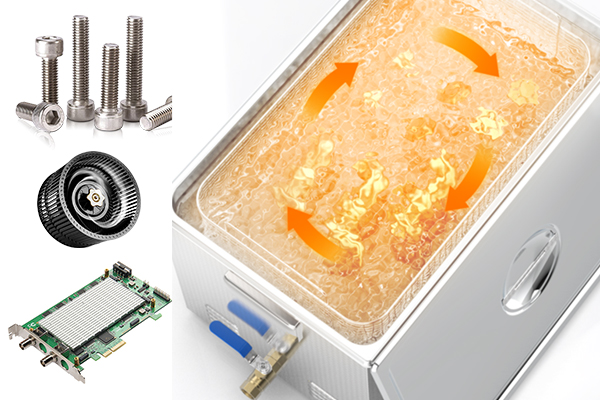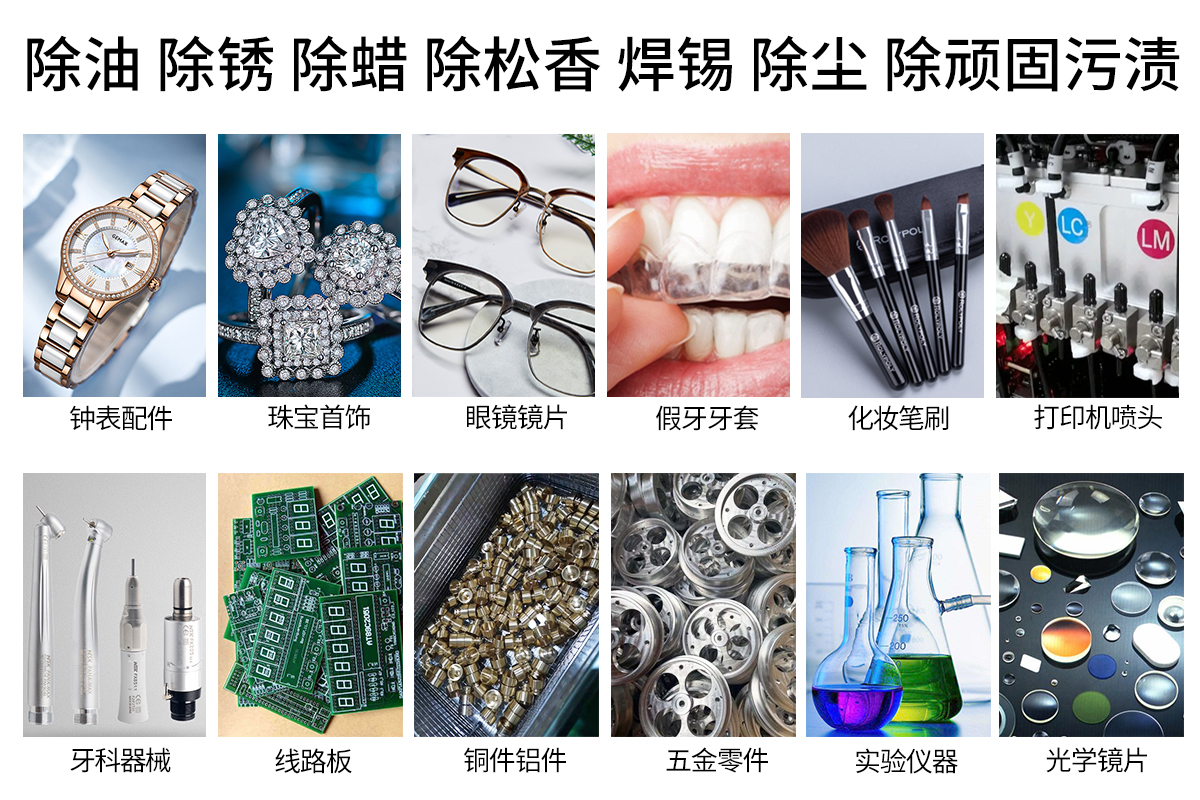Ultrasonic cleaning may sound like something futuristic, but the technology has been around and evolving for decades. Its ability to gently and thoroughly clean delicate objects—without abrasion or harsh chemicals—makes it a trusted method in industries like healthcare, precision manufacturing, and optical care.
At the core of ultrasonic cleaning is a phenomenon called acoustic cavitation. When high-frequency sound waves—usually between 20kHz and 200kHz—are transmitted through a liquid, they create alternating high-pressure and low-pressure cycles. In the low-pressure phases, microscopic vapor bubbles form. These bubbles are extremely unstable and collapse violently during the next high-pressure cycle. The collapse creates intense local energy—enough to dislodge even microscopic particles from a surface.
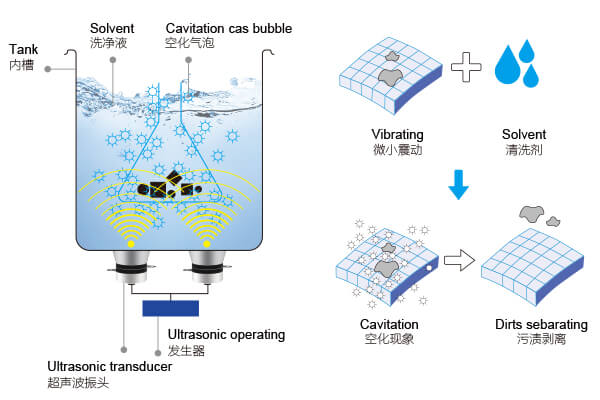
Because the bubbles are so small, they can penetrate fine crevices, pores, and complex shapes that brushes and cloths can’t reach. That’s why ultrasonic cleaners are so effective for items like surgical tools, electronic circuit boards, jewelry, and, yes—eyeglasses.
Eyeglasses often accumulate invisible films of oil, dust, pollen, and dried-on residue in places that are hard to reach with wipes or sprays. Cavitation bubbles reach into the hinges, around the nose pads, and along the lens edges, providing a level of cleaning that’s hard to achieve manually without risk of scratching.
Importantly, the process is non-mechanical. There’s no rubbing or scraping. Instead, the fluid does the work—with help from physics.
Why People Use Ultrasonic Cleaners for Glasses
If you wear glasses daily, you know how quickly they get dirty. Smudges, skin oils, airborne particles, and environmental debris seem to find their way onto lenses no matter how careful you are. Cleaning them with a microfiber cloth or lens wipe works—but only to a degree. It’s difficult to get into the tiny crevices of the hinges, nose pads, or the fine groove where the lens sits in the frame.
This is where ultrasonic cleaning offers real value. It provides a thorough, even cleaning across the entire surface of the glasses, including hard-to-reach areas. For people who wear glasses every day—especially those working in dusty, oily, or humid environments—it’s an effortless way to restore clarity without damaging coatings or stressing fragile frames.
Beyond convenience, the method is gentle and consistent. Manual cleaning can introduce micro-scratches over time, especially if there’s grit on the lens surface or the cleaning cloth isn’t perfectly clean. Over time, those scratches accumulate and reduce lens clarity.
With ultrasonic cleaning, there’s no physical contact between the lens surface and a cleaning tool. The cleaning action comes from thousands of tiny imploding bubbles—so there’s virtually no abrasion.
Opticians and eyewear retailers sometimes use ultrasonic cleaners to give customers’ glasses a refresh during service appointments. And many consumers have begun to invest in compact home ultrasonic cleaners to clean not only their glasses, but also jewelry, retainers, and watches.
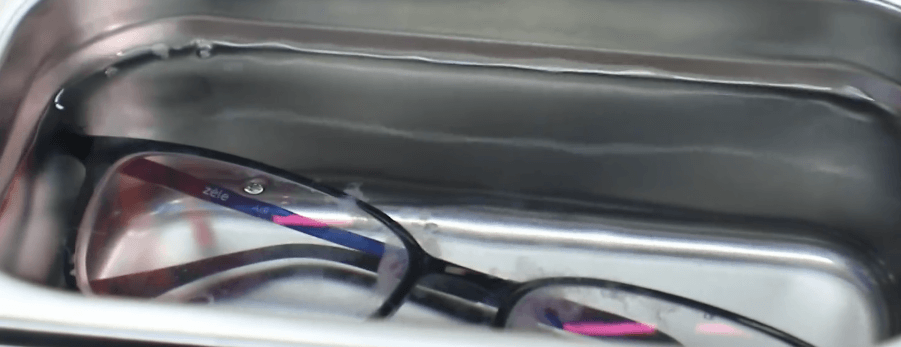
Are All Types of Glasses Safe for Ultrasonic Cleaning?
In general, most modern eyeglasses are safe to clean in an ultrasonic cleaner, especially when the cleaner is used correctly and within recommended settings.
Prescription glasses made from polycarbonate or high-index plastic lenses respond well to ultrasonic cleaning. Frames made from metal or durable plastic also handle the process without issue. Additionally, sunglasses, safety goggles, and sports glasses can often benefit from ultrasonic cleaning—especially models with hard-to-clean shapes or lens grooves.
However, it’s essential to consider the lens coatings applied. Many lenses today come with anti-reflective (AR) coatings, blue-light filters, photochromic layers (such as Transitions), or hydrophobic top coats. These coatings are typically durable, but they may have varying tolerances to prolonged ultrasonic exposure, especially at high temperatures.
Coated lenses are generally safe in ultrasonic baths as long as:
- The water temperature remains below 50°C (122°F)
- Cleaning time stays within 2–5 minutes
- Only lens-safe solutions or plain distilled water are used
Professional sources—including optometry associations—suggest that ultrasonic cleaning is appropriate for high-quality coated lenses as long as the equipment is designed for optical use and operated within safe parameters.
Moreover, glasses with silicone nose pads, spring hinges, or adjustable arms are also good candidates for ultrasonic cleaning. Cavitation bubbles are particularly effective at removing grime buildup from these areas without taking the frames apart.
Which Glasses Should NOT Be Cleaned Ultrasonically?
Despite its reputation for gentle precision, ultrasonic cleaning is not suitable for every pair of glasses. Certain materials and conditions can make your eyewear vulnerable to damage if not handled properly. It’s important to recognize when ultrasonic cleaning could cause more harm than good.
The most common issue arises with already-damaged or heavily worn glasses. If your lenses have deep scratches, loose coatings, or chips along the edge, ultrasonic cleaning may worsen the damage. Cavitation energy—though subtle—can exploit existing weaknesses, especially where coatings are delaminating or where lens bonding has deteriorated.
Old, glued-together frames—especially vintage or low-cost models—can also be problematic. Some older plastic frames or nose pads may be bonded with adhesives that soften or break down under the heat and agitation of an ultrasonic bath. Similarly, metal frames with corrosion at the joints may start to loosen further.
Heat-sensitive coatings or film layers applied to budget sunglasses may peel or blister, particularly if the bath exceeds recommended temperatures. Likewise, cheap polarized films that aren’t embedded in the lens substrate are prone to bubbling when exposed to ultrasonic energy and warmth.
Additionally, rimless glasses that use pressure-mounted lenses can be vulnerable if the mounting hardware is already under stress. The vibration from cleaning may loosen these parts or cause subtle shifts in alignment.
If you’re unsure whether your glasses are compatible, consult your optician or the lens manufacturer. Many provide care guidelines that include specific notes about ultrasonic cleaning. When in doubt, it’s safer to use manual cleaning methods for older, damaged, or non-standard eyewear.
What Happens When You Clean Glasses in an Ultrasonic Cleaner?
When glasses are cleaned in an ultrasonic bath, the process appears simple from the outside, but what’s happening beneath the surface is highly sophisticated. As the ultrasonic waves pass through the cleaning fluid—typically distilled water with a mild, lens-safe detergent—they trigger the rapid formation and collapse of microscopic bubbles.
These bubbles are not just random; they form in every corner of the submerged item, including the hinges, around screws, under nose pads, along the edges of the lenses, and even within tiny crevices of the frame. When the bubbles collapse, they release just enough force to break the bond between the contaminant and the lens surface, lifting oils, particles, skin debris, and even dried sweat residue.
One of the most noticeable effects after a proper ultrasonic cleaning is the restoration of lens clarity. Even if your glasses looked “clean” before, you’ll often notice sharper vision, fewer halos from reflections, and more comfort—especially if buildup around the nose pads or frame edges had gone unnoticed.
The process typically takes between 10 to 30 seconds, depending on the unit and level of contamination. The bath often includes a mild heating element to keep the temperature around 30–40°C, which helps soften oils and speed up cleaning.
After the cycle is complete, the glasses should be carefully removed and rinsed with clean water to eliminate any remaining solution. They can be dried with a lint-free microfiber cloth or allowed to air dry on a clean surface.
Used correctly, an ultrasonic cleaner leaves glasses not just visibly cleaner—but hygienically cleaner, removing microscopic particles and biofilms that ordinary wipes often miss.
Friendly reminder: For most lenses, when using an ultrasonic cleaner, the cleaning time should not exceed 30 seconds.
Recommended Ultrasonic Cleaner Settings for Glasses
To safely clean glasses in an ultrasonic cleaner, it’s important to use the right settings. The machine’s frequency, power, time, and temperature all play a role in whether the result is a safely cleaned lens—or a damaged one.
Most optical professionals agree that for eyewear, an ultrasonic frequency of 40kHz or higher is ideal. Lower frequencies (like 25–28kHz) produce larger bubbles with more forceful collapses, which are better suited for heavy industrial cleaning. These could be too aggressive for coated lenses or fragile frames.
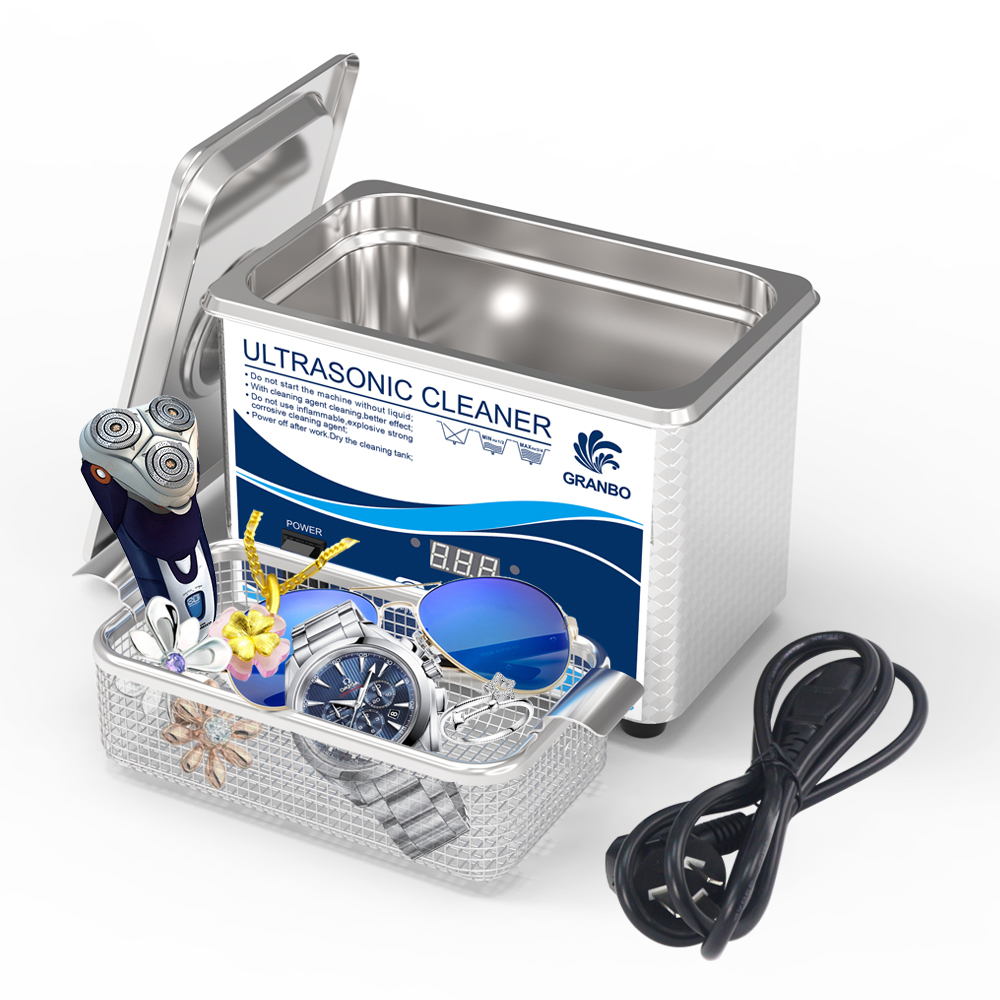
Here are the key recommended settings for safe glasses cleaning:
- Frequency: 40kHz–60kHz (gentle but effective for coatings and fine hinges)
- Cleaning Time: 2–5 minutes maximum
- Temperature: 30°C–40°C (86°F–104°F)
- Solution: Mild detergent or specialized lens cleaning fluid diluted in distilled water
Avoid prolonged exposure or multiple consecutive cycles. Excessive time in the cleaner can weaken lens coatings, loosen frame hardware, or cause minor optical distortion. Some users make the mistake of “running a second cycle just to be sure,” but this is rarely necessary and may cause harm.
Additionally, always suspend the glasses in the cleaning basket rather than placing them directly on the bottom of the tank. This ensures even cleaning and protects the frame from mechanical vibration damage.
Professional optical service centers often use ultrasonic units with pre-programmed eyewear settings. If using a home unit, it’s wise to follow the cleaner’s instruction manual and stick with conservative settings for glasses.
What Cleaning Solution Should Be Used for Eyewear?
Choosing the right cleaning solution is just as important as setting the correct frequency or temperature. The cleaning fluid in an ultrasonic bath does more than just fill the tank—it directly affects how well the cavitation process works, how safely the lenses are cleaned, and whether coatings remain intact.
For cleaning glasses, it’s best to use distilled water mixed with a mild, non-abrasive, non-alcoholic detergent designed specifically for optical use. Many manufacturers produce ultrasonic cleaning concentrates formulated for lenses, frames, and delicate coatings. These are often pH-neutral and contain surfactants that break down oils and remove skin residue without harming coatings.
A typical dilution ratio is 1 part concentrate to 20–40 parts water, but always check the manufacturer’s instructions. Using too much concentrate can lead to suds or residue; too little may reduce cleaning efficiency.
Avoid any solution that contains:
- Alcohol
- Ammonia
- Acetone
- Chlorine bleach
- Vinegar or acidic agents
These chemicals can strip anti-reflective coatings, damage UV protection layers, or cause micro-etching on polycarbonate lenses. Even over-the-counter glass cleaners that are safe for windows are not suitable for eyewear, as they are typically too harsh.
Some users are tempted to make DIY mixtures with dish soap or hand soap, but these can contain moisturizers, thickeners, or fragrances that leave a film on lenses and interfere with cavitation. If you must use a household product, opt for a clear, fragrance-free dish soap—but only in very small amounts and only if no better option is available.
For best results, combine distilled water with a commercial optical cleaning concentrate that has been tested on multi-coated lenses. This ensures optimal cleaning without the risk of degradation.
Step-by-Step Guide to Cleaning Your Glasses Safely
Ultrasonic cleaning might sound complicated, but the actual process is very straightforward. With just a few steps and a little attention to detail, you can safely and effectively deep-clean your glasses at home or in a clinic setting.
Here’s how to do it:
Step 1: Prepare the Machine
Fill the ultrasonic tank with distilled water. Add the appropriate amount of lens-safe cleaning concentrate according to the instructions.
Step 2: Degas the Solution
Run the machine (without your glasses inside) for 3–5 minutes. This removes dissolved gases that reduce cavitation effectiveness.
Step 3: Place the Glasses Properly
Insert your glasses into the provided basket or tray. Make sure they are not touching the bottom of the tank and are fully submerged. If cleaning multiple pairs, space them apart to avoid contact.
Step 4: Set the Parameters
Set the machine to 40kHz, 2–5 minutes, and a temperature of 30–40°C. Avoid higher settings unless you’re using a commercial unit designed for optical cleaning.
Step 5: Start the Cleaning Cycle
Let the machine run for the selected time. You’ll often see small bubbles forming around hinges and nose pads—this is cavitation in action.
Step 6: Remove and Rinse
When the cycle ends, lift the glasses carefully from the bath. Rinse them under clean, lukewarm water to remove any leftover detergent.
Step 7: Dry and Inspect
Use a lint-free microfiber cloth to gently pat dry the glasses. Avoid paper towels, which can scratch lenses. Inspect your lenses in good light—you should see a noticeable improvement in clarity and cleanliness.
Following this process ensures not only clean glasses but also long-term protection of your frames and coatings. Doing it right the first time avoids the need for repeated cleaning cycles or costly repairs.
Can Ultrasonic Cleaners Damage Glasses? What to Watch Out For
Ultrasonic cleaning is generally safe for modern eyewear, but misuse or poor settings can lead to unintended damage. Knowing what to watch for helps ensure that your ultrasonic cleaner remains a valuable tool—not a source of problems.
The most common risk is to lens coatings, particularly anti-reflective (AR), photochromic, and hydrophobic coatings. These layers are typically bonded to the lens surface during manufacturing and are designed to withstand normal use. However, prolonged exposure to ultrasonic waves—especially at high temperatures—can cause these coatings to weaken, bubble, or delaminate, particularly on older lenses or lower-quality coatings.
Another concern is with frame construction. Frames that rely on tiny screws, springs, or pressure mounts can gradually loosen over time with repeated ultrasonic use. This doesn’t mean the cleaner is “too powerful”—it simply highlights the mechanical vibration’s ability to nudge loose hardware. If your frame already has a wobbly arm or hinge, ultrasonic cleaning may cause it to fully detach.
Rimless or semi-rimless glasses, where lenses are mounted under tension, are also at risk if cavitation causes uneven stress along the mounting points. Although rare, lens shifting or fine cracking can occur if the frame is poorly constructed or the cleaning duration is too long.
Additionally, if the wrong cleaning solution is used—especially those containing alcohol or ammonia—the surface of plastic lenses can become cloudy or brittle over time. This is why optical-grade solutions are essential for long-term lens health.
Poor practices like placing glasses directly on the bottom of the tank, running the cycle too long, or heating above 50°C can all increase the risk of damage. These mistakes are entirely avoidable with proper use and attention to equipment instructions.
The safest approach is to:
- Use a dedicated optical cleaning solution
- Set time and temperature conservatively
- Avoid cleaning damaged or delaminating lenses
- Always inspect glasses after each cleaning session
When used properly, ultrasonic cleaning can extend the life of your glasses—not shorten it. But like any tool, the result depends on how it’s handled.
What Do Optometrists and Manufacturers Say?
Professionals in the optical industry generally support the use of ultrasonic cleaners for glasses, provided that best practices are followed. Many eyewear retailers and optometry clinics use ultrasonic cleaning as part of their standard service, offering it to patients during checkups or adjustments.
According to guidance published by major lens manufacturers and optical care associations, ultrasonic cleaning is:
- Safe for coated lenses, when done at moderate temperatures
- Effective at removing biofilms, skin oils, and airborne pollutants
- Preferred over abrasive wiping, which can lead to micro-scratches
The American Optometric Association recommends cleaning lenses using non-abrasive solutions and soft materials, and specifically notes that ultrasonic cleaning is suitable when performed using equipment designed for optical care.
A 2019 industry study published in Clinical Optometry found that patients who regularly used ultrasonic cleaners experienced fewer coating failures and better overall lens transparency after one year of use compared to those who only used manual cleaning methods.
Lens manufacturers have also issued guidelines cautioning against high temperatures and aggressive chemicals, but they acknowledge ultrasonic cleaning as a recommended method—especially in retail environments.
Some eyeglass brands even include ultrasonic cleaner compatibility in their care instructions, specifying maximum recommended temperatures and durations.
Ultrasonic Cleaning vs. Manual Cleaning: Which Is Better for Glasses?
There’s a longstanding debate among glasses wearers: Is it better to clean your glasses manually or use an ultrasonic cleaner? The truth is, both methods have their place—but they serve different purposes and offer distinct advantages depending on the situation.
Manual cleaning is fast, accessible, and convenient. With a microfiber cloth and a bottle of lens cleaner, you can remove smudges, fingerprints, and surface debris in seconds. It’s ideal for quick touch-ups throughout the day or when you’re on the move. However, manual cleaning can be inconsistent. If the cloth is dirty or used too aggressively, it can cause micro-scratches over time. It also doesn’t address buildup around the hinges, nose pads, or within the rim of the lens where oils and grime accumulate invisibly.
Ultrasonic cleaning, by contrast, excels at deep cleaning. It reaches into areas a cloth can’t access and removes microscopic contaminants without direct contact. This is particularly valuable for people with allergies or sensitive skin, where invisible debris on frames and lenses may cause irritation. The process is especially effective for removing sebaceous oils, pollen, dried sweat, and airborne particles that settle into frame joints.
From an optical standpoint, ultrasonic cleaning provides a more uniform and non-abrasive clean. A study conducted by a group of optical lens engineers found that repeated manual wiping with standard microfiber cloths introduced measurable haze on lens surfaces after just 60 cleaning cycles, whereas ultrasonic cleaning showed no measurable surface degradation after 100 cycles under controlled conditions .
So which is better?
- For daily maintenance: manual cleaning is more practical.
- For periodic deep cleaning: ultrasonic cleaning provides superior results and longer-term lens health.
- For sensitive lenses: ultrasonic methods reduce the risk of scratches or pressure-related stress.
Ultimately, combining both methods is often the best solution. Use manual cleaning for day-to-day clarity and rely on ultrasonic cleaning weekly or biweekly to restore full transparency and hygiene.
How Often Should You Clean Glasses Ultrasonically?
Ultrasonic cleaning is powerful, but like any deep-cleaning method, frequency matters. Using it too often may place unnecessary wear on delicate coatings and hardware, while using it too infrequently allows grime to build up in places manual cleaning can’t reach.
For most glasses wearers, cleaning glasses in an ultrasonic cleaner once every one to two weeks is sufficient. This schedule removes deep-seated oils, pollen, and environmental debris without overexposing the lenses or frames to repeated vibration and moisture.
However, your lifestyle and environment can change that frequency. If you work in a dusty warehouse, kitchen, or workshop—or if you’re outdoors frequently—your glasses may need ultrasonic cleaning every few days to maintain visibility and hygiene. On the other hand, if your daily environment is clean and you’re diligent with manual wiping, monthly ultrasonic cleaning might be enough.
Professionals generally advise against daily use of ultrasonic cleaners for eyewear unless the cleaner is specifically engineered for that frequency of operation and used with conservative settings. Overuse—especially with excessive time or temperature—can degrade hydrophobic coatings or cause fine hardware to loosen over time.
Lens and frame manufacturers often provide their own recommendations. For example, some optical coating suppliers note that ultrasonic cleaning every 7–14 days at 40kHz, under 40°C for no more than 30 seconds, is safe for most multi-coated lenses.
Ultimately, the safest approach is to adopt a hybrid routine:
- Use manual cleaning daily for visible smudges and dust
- Perform ultrasonic cleaning weekly or biweekly for a deep, even cleanse
- Adjust frequency based on exposure to sweat, oil, dust, or chemicals
Establishing a smart cleaning schedule helps preserve lens transparency, extends the life of your frame, and keeps your glasses both functional and comfortable.
Portable vs. Professional-Grade Ultrasonic Cleaners for Eyewear
If you’ve decided to invest in an ultrasonic cleaner for your glasses, one of the first decisions you’ll face is choosing between a portable/home-use unit and a professional-grade model. While both rely on the same core technology—ultrasonic cavitation—their performance, build quality, and capabilities vary significantly.
Portable Home Units
Compact ultrasonic cleaners designed for consumer use are affordable, lightweight, and typically hold between 200ml to 700ml of liquid—just enough to submerge a pair of glasses. Most of these devices operate at a fixed frequency of 40kHz, which is safe for most lens coatings. They’re easy to use and often feature one-touch operation with auto shutoff timers ranging from 3 to 10 minutes.
These units are ideal for:
- Daily or weekly home use
- Light to moderate cleaning needs
- Users with one or two pairs of glasses
However, there are some limitations. Home models typically lack temperature controls or advanced cleaning cycle customization. The cavitation intensity is moderate, which works fine for general cleaning but may be insufficient for removing stubborn grime or mineral deposits. Build materials also vary—lower-cost models may use plastic tanks, which are less durable than stainless steel options.
That said, many users report excellent results with these devices when used for eyeglasses, jewelry, and small accessories. For budget-conscious consumers or casual glasses wearers, they offer an excellent balance of convenience and effectiveness.
Professional-Grade Cleaners
On the other end of the spectrum are commercial ultrasonic cleaners commonly found in optical labs, hospitals, and retail eyewear shops. These models offer greater power output, capacity, and control features, including:
- Adjustable frequency and power settings
- Precise temperature regulation
- Digital timers with programmable cleaning cycles
- Larger tanks for multi-item batches
Some high-end units allow cleaning at multiple frequencies—e.g., 40kHz for general use and 80kHz for ultra-fine cleaning—which is beneficial for optical lenses with complex coatings or fragile frames. Others include sweep frequency technology, which improves uniformity and avoids “dead zones” in the tank.
Professional models are ideal for:
- Optometrists or eyewear retailers offering in-store cleaning
- Laboratories processing large volumes of optical tools
- Users cleaning multiple pairs of glasses or devices regularly
Of course, they come with a higher price tag and are less portable. For the average consumer, the investment might not be justified unless they have other precision-cleaning needs—like cleaning dental tools, watches, or camera lenses.
According to a comparative review published in Optical Technology Review, home-use cleaners performed well for general lens hygiene, but professional systems delivered consistently higher particle removal and frame sanitation, especially when cleaning multiple items in a single batch.
Choosing the Right Fit
The choice depends largely on your budget, frequency of use, and performance expectations. For most everyday users, a mid-range portable cleaner with a stainless-steel tank and fixed 40kHz output is more than adequate. But for professionals or those with multiple eyewear users in the household, stepping up to a more advanced model may be worth the investment.
Real-World Feedback: What Users Say About Cleaning Glasses Ultrasonically
Beyond specifications and technical guidance, real-world user experiences offer valuable insight into how ultrasonic cleaning performs in daily life. Across forums, product reviews, and optical communities, feedback about cleaning glasses with ultrasonic cleaners tends to be overwhelmingly positive—especially when users follow recommended practices.
Reported Benefits
Many users describe ultrasonic cleaning as a game-changer for lens clarity. People often report that their glasses appear clearer than new, especially after the first few cleanings. It’s not uncommon to hear comments like:
“I thought my lenses were clean until I tried the ultrasonic cleaner—now I realize I had a fine layer of film I could never get rid of manually.”
Commonly praised outcomes include:
- The complete removal of grime around nose pads and hinges
- Noticeably better vision due to clearer lenses
- A fresher, more hygienic feel—especially for glasses worn in humid or oily environments
- Less need for daily wiping and fewer smudge marks throughout the day
Parents of children who wear glasses often appreciate the ease and speed of ultrasonic cleaning, as it reduces the hassle of repeatedly wiping smudged lenses. Similarly, people with allergies report reduced eye irritation when cleaning is done regularly with an ultrasonic device.
Criticisms and Cautions
Despite the praise, some users do encounter issues—usually due to improper usage. Over-cleaning, running cycles that are too long, or using the wrong type of solution are the most common causes of dissatisfaction.
In a few cases, users noted that low-cost ultrasonic cleaners failed to deliver noticeable improvements, especially when dealing with stubborn oils or older residue. These reports often involve units with plastic tanks, very low power output, or fixed short cleaning cycles.
Some users also mention hardware issues, like screws loosening or nose pads falling off. While these effects are rare, they highlight the importance of inspecting your frames before and after cleaning—especially if your glasses are old or have been previously repaired.
There’s also the issue of expectation mismatch. Ultrasonic cleaning is not magic—it won’t fix scratched lenses or worn coatings. Users expecting their scratched lenses to “look new” often express disappointment when the cleaner does not restore physical damage.
A survey of over 300 eyewear owners published by VisionCare Today found that nearly 92% of users who followed the manufacturer’s guidelines were satisfied with their ultrasonic cleaner for eyeglass maintenance, while most complaints came from cases involving improper use or substandard equipment.
What Users Recommend
Experienced users often share similar advice:
- Don’t overfill or underfill the tank
- Use distilled water and optical-safe detergent only
- Don’t expect miracles—expect precision
- Clean every 1–2 weeks, not daily
- Avoid super-cheap models with unknown brands
By setting realistic expectations and following best practices, most users find that ultrasonic cleaning quickly becomes a standard part of their glasses care routine—one that saves time, preserves lens quality, and delivers noticeably clearer vision.
Cost Considerations and Long-Term Lens Care
When evaluating whether to invest in an ultrasonic cleaner for glasses, cost versus benefit is a common concern. Prices for consumer-grade units typically range from $25 to $150, while professional or commercial-grade models can run anywhere from $300 to over $1000, depending on tank size, features, and build quality.
For the average glasses wearer, a mid-range consumer model with a stainless steel tank, fixed 40kHz frequency, and 3–5 minute timer offers the best balance of affordability and performance. These units are durable enough for weekly use and gentle enough for coated lenses.
Now, consider the potential savings over time:
- Fewer visits to optical shops for professional cleaning
- Reduced lens replacements due to scratch avoidance
- Less money spent on disposable wipes, sprays, and tissues
- Lower risk of damaging expensive AR coatings from improper manual cleaning
A single pair of high-end prescription lenses can cost hundreds of dollars, especially when anti-glare, photochromic, or blue light filters are added. If ultrasonic cleaning can preserve those coatings for an extra year or two, the return on investment is clear.
Additionally, most ultrasonic cleaners are multi-functional. Beyond glasses, they can clean jewelry, watches, dentures, retainers, makeup tools, coins, and small metal parts. This multi-use value enhances their long-term cost-effectiveness.
In terms of maintenance, ultrasonic cleaners require little upkeep. Replace the cleaning solution after each use or every few cycles (depending on contamination), and occasionally wipe the tank clean. Some advanced models also include filter systems or drain valves for easier care.
From a lens care perspective, ultrasonic cleaning helps preserve:
- Surface coatings (by reducing abrasive manual contact)
- Lens clarity (by removing biofilm and invisible particles)
- Frame alignment (when cleaning is done correctly, without impact or overuse)
However, ultrasonic cleaning does not fix scratched or delaminated lenses, and it won’t prevent mechanical frame wear. It should be seen as a powerful maintenance tool—not a solution for physical damage or long-overdue replacements.
According to data shared by optical insurance provider LensSure, policyholders who used ultrasonic cleaning at least twice per month reported up to 30% fewer lens replacements due to visible wear or coating damage over a 3-year period.
For anyone wearing prescription lenses daily—especially those working in active environments—the upfront cost of a quality ultrasonic cleaner is often offset within a year by better lens performance, longer wear life, and fewer professional cleanings.
Best Practices for Long-Term Lens Clarity and Comfort
Ultrasonic cleaning is a powerful way to keep glasses clear and hygienic, but maintaining lens quality over the long term also requires good daily habits and thoughtful handling. When combined with routine ultrasonic cleaning, these best practices can significantly extend the life of your lenses and frames.
Store Glasses Properly
Always place your glasses in a hard-shell case when not in use. Leaving them exposed on desks, inside bags, or on fabric surfaces exposes lenses to dust, abrasion, and accidental impacts. Even minor surface grit can lead to scratches if it’s pressed or rubbed into the lens with a cloth.
Avoid Harsh Environments
While glasses are built to handle daily wear, prolonged exposure to chemicals, heat, or extreme sunlight can wear down coatings and warp frames. Avoid leaving glasses on car dashboards, next to stoves, or in areas with strong solvents or cleaning products.
Clean Smudges Gently
Between ultrasonic cleaning sessions, use a high-quality microfiber cloth and a dedicated lens spray for daily touch-ups. Avoid paper towels, napkins, or shirt sleeves, all of which can scratch lens coatings even if they feel soft.
Never rub a dry lens—always mist it first with cleaning fluid or water to lift dirt before wiping. Dry friction is one of the main causes of long-term optical haze and micro-scratches.
Inspect Regularly
Check for signs of wear such as:
- Loose screws or nose pads
- Peeling or cloudy coatings
- Lens wobble in the frame
- Warping in plastic components
If you notice any of these issues, address them before ultrasonic cleaning. For example, loose screws should be tightened to prevent them from detaching during a cleaning cycle.
Handle with Clean Hands
It’s easy to transfer oils, sunscreen, or hand lotion to your lenses. These substances not only smudge but may also contain ingredients that degrade lens coatings over time. Washing your hands before handling your glasses can make a big difference.
Replace Cleaning Fluids Regularly
If you’re using an ultrasonic cleaner with reusable solution, be sure to replace the fluid after several cycles or whenever it appears cloudy. Contaminated solution can redeposit grime onto lenses and reduce the effectiveness of cavitation.
Combine with Professional Care
Even with ultrasonic cleaning, it’s a good idea to have your glasses professionally checked once or twice a year—especially if you’re wearing prescription lenses. Opticians can verify alignment, refit loose frames, and clean parts that home units may not reach effectively.
By integrating these best practices into your routine, you not only maintain lens clarity but also support long-term comfort, durability, and visual performance.
As supported by optical ergonomics specialists, daily user habits play just as large a role in lens preservation as periodic ultrasonic cleaning. Combining the two approaches offers the best protection against coating wear, frame fatigue, and vision distortion.
Advancements in Ultrasonic Cleaning for Optical Applications
As ultrasonic cleaning continues to evolve, recent innovations have focused on improving safety, precision, and user experience—especially for sensitive items like eyeglasses. These advancements are shaping the future of optical care, making ultrasonic cleaning more accessible and effective than ever.
Smart Cleaning Systems
One of the most notable developments is the integration of smart controls into compact ultrasonic devices. Modern cleaners now feature touchscreen interfaces, cycle memory, and adaptive power settings that automatically adjust based on the load in the tank. Some models can detect the type of object being cleaned and fine-tune the cavitation intensity accordingly.
This is particularly beneficial for glasses with delicate lens coatings or composite frame structures, where uniform cleaning without overexposure is critical.
Multi-Frequency Cleaning
While early ultrasonic cleaners operated at a fixed frequency (typically 40kHz), newer models are capable of multi-frequency operation, often switching between 40kHz and 80kHz within a single cleaning cycle. This allows for:
- Gentle agitation at higher frequencies for fragile coatings
- Stronger cavitation at lower frequencies for stubborn grime around hardware
Some professional systems even include frequency sweeping technology, which dynamically shifts the frequency ±1–2kHz during a cycle to eliminate standing wave patterns and ensure uniform cavitation throughout the tank.
Compact and Quiet Designs
Consumer demand has pushed manufacturers to reduce the size and noise level of ultrasonic cleaners. Today’s devices are often compact enough to sit on a bathroom shelf, with sound insulation that keeps them quieter than an electric toothbrush.
Some brands also offer wireless or USB-powered units, allowing glasses to be cleaned even while traveling—ideal for frequent flyers or field professionals who rely on crystal-clear vision.
Enhanced Safety Features
Newer ultrasonic cleaners now include:
- Overheat protection, which prevents accidental overheating of the solution
- Auto shutoff after inactivity, for energy conservation and safety
- Leak-proof stainless steel tanks, reducing the risk of electrical hazard
These features help ensure that even inexperienced users can safely clean their glasses without damaging lenses or risking accidents.
Integration with Optical Retail Services
In retail environments, ultrasonic cleaning is now being bundled into value-added eyewear care services. Optical chains and boutique eyewear shops increasingly offer ultrasonic deep-cleaning as part of warranty packages or subscription care plans, using high-end ultrasonic stations with temperature-controlled cycles and UV disinfection stages.
There is also growing research into combining ultrasonic cleaning with UV-C light treatment to simultaneously disinfect and clean eyeglasses—a trend driven by post-pandemic hygiene standards.
According to a 2023 report from the Optical Technology Innovation Forum, more than 60% of new ultrasonic cleaning devices released that year featured dual-mode cleaning with disinfection capability, a trend expected to grow as consumer hygiene awareness increases.
Final Thoughts: Should You Use an Ultrasonic Cleaner for Glasses?
Ultrasonic cleaning has become a trusted method for maintaining eyeglasses—not just among professionals, but also for everyday users seeking convenience, clarity, and long-term lens care. While manual cleaning methods still have their place for daily smudge removal, the advantages of ultrasonic cleaning are hard to ignore when it comes to deep cleaning, hygiene, and coating preservation.
What sets ultrasonic cleaning apart is its non-contact precision. It eliminates the need for rubbing or pressure, both of which contribute to scratches, coating degradation, and premature lens wear. It reaches areas that microfiber cloths cannot—like under nose pads, around hinges, and along the lens edge. For people who wear glasses every day, especially in challenging environments, this level of cleanliness can make a noticeable difference in comfort and performance.
When used correctly—at the right frequency, time, and temperature, and with proper cleaning solutions—ultrasonic cleaners are remarkably safe for most modern lenses and frames. They’re especially beneficial for lenses with anti-reflective or blue-light coatings, which are sensitive to abrasion and harsh chemicals. By following basic precautions and care routines, users can extend the life of their eyewear and maintain lens clarity for years longer than with manual cleaning alone.
That said, ultrasonic cleaning is not for every situation. Glasses that are already damaged, poorly assembled, or equipped with fragile decorative elements may require special care or manual cleaning alternatives. And for the few lens materials or coatings that are highly heat-sensitive, ultrasonic use may need to be avoided or adjusted to lower settings.
Ultimately, investing in an ultrasonic cleaner—especially a mid-range model designed with optical use in mind—offers excellent value for glasses wearers. Whether for routine weekly cleaning or a monthly deep-cleaning routine, this technology allows for optical-grade results at home, with minimal effort.
Combined with good storage habits, proper wiping techniques, and occasional professional checks, ultrasonic cleaning becomes a vital part of an eyewear care routine—helping you protect your vision, preserve your investment, and see the world clearly every day.

